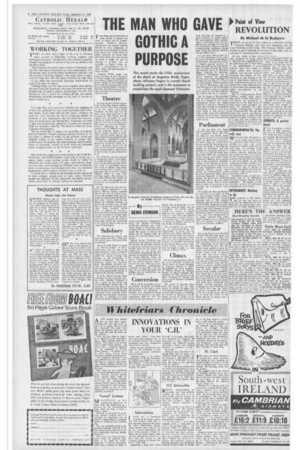Page 4, 21st September 1962
Page 4

Report an error
Noticed an error on this page?If you've noticed an error in this article please click here to report it.
Tags
Share
Related articles
Pugin Lover Of Pyx And Chasubles
Farm Street Celebrates
`cabbie — Sumner Place Pleases
Hardman: A Master Of Colour And Light Is Honoured In...
John Battle Mp
THE MAN WHO GAVE GOTHIC A PURPOSE
This month marks the 110th anniversary of the death of Augustus Welby Pugin, whose influence lingers in current church building projects, and in the movement to rehabilitate the much despised Victorians
TT has long been fashionable in -1some circles to despise the work of Pugin and his contemporaries: Imitative', 'gloomy', 'unoriginal' are typical epithets hurled in hasty judgement at even the best examples of Gothic Revival art. But to-day when we pride ourselves on being wellinformed about the latest trends in styles it might be just to attempt to re-think our old attitudes to Pugin's work. Indeed a re-examination of his ideas, aims and achievements is long overdue.
Augustus Welby Pugin was born in London in 1812, the son of a French emigre who practised as an architect. Pugin was brought up by his mother in the Presbyterian faith, and the strictness with which she enforced his chapel attendances has been put forward as contributing to his reaction in favour of the Catholic faith.
Theatre
Life was hard for all the apprentices in the elder Pugin's architectural 'school'. They were expected to do two hours' work before breakfast, and they had only the hours from eight until ten in the evenings for their leisure. But the regime was enlivened by tours abroad to study the great cathedrals of France. It is on these tours that Pugin as a boy first showed a marked enthusiasm for Gothic architecture. At home he stood up to the gruelling regime of his father's 'atelier' in spite of somewhat delicate health, and by the age of fourteen was making his first independent architectural venture —a full and scholarly survey of Rochester Cathedral. There in a minor adventure, typical of the eventful life he lived, he narrowly escaped death when a trench caved in the moment he had climbed out of it.
The following year he executed a commission given to his father. to design furniture in the Gothic style for the newly-restored Windsor Castle—a remarkable success for a boy of fifteen. Next Pugin was introduced by a friend to the backstage life of Covent Garden Theatre. There he took work painting scenery. His designs for the ballet 'Kenilworth' turned out to be a new and thoughtful improvement on traditional scenery painting.
But this phase also did not last. Pugin became enamoured of the sea—a lifelong passion equalled only by his love of Gothic architecture. He bought a boat, but was as quickly shipwrecked off the Scottish coast. In his plight he was helped by Gillespie Graham, an Edinburgh architect, who advised him to follow his profession seriously. Pugin promptly settled down at eighteen by starting a business and by getting married. He set up a workshop to produce ornamental carvings, but his business sense was not equal to his technical knowledge, and so the venture had to be given up when he was on the verge of bankruptcy.
Salisbury
The following year Pugin's wife died leaving him with a baby girl. He married again, and went to live at Salisbury.
There he built himself a house —St. Marie's Grange. It had a drawbridge from the road to the main entrance—a type of medieval fantasy that was soon to be superseded by serious writings and designs in the furtherance of Gothic architecture. His life at Salisbury marks the transition from high-spirited youthful activities to high-minded and unceasing work furthering the dignity of the newly-emancipated Church in England through her buildings.
From St. Marie's Grange, Pugin published his first important literary work. Entitled 'Contrasts' it was a satire on the artistic and social differences between the 15th century and his own day. Pairs of drawings were placed side by side which illustrated in telling fashion contrasted towns, churches, tombs, colleges and episcopal residences. The pair of drawings of a town illustrated Pugin's medieval dream world alongside the contemporary world that included toll-bridge, workhouse, gasworks, etc. 'Contrasts' marks an important stage in Pugin's life, for it first illustrates clearly his desire to restore the glories of the ancient faith by means of a revived Gothic architecture.
Shortly before 'Contrasts' was published, Pugin was received into the Church. He has been unfairly accused of an insincere conversion, brought about by his interest in medievalism, or his desire for architectural commissions. But his sincerity is attested by his letter to his friend Osmond where he writes: "I feel perfectly convinced that the Roman Catholic faith is the only true one." There are, however. permissible architectural overtones, for he adds: "and the only one in which the good and sublime style of architecture can ever be restored".
Conversion
There can be no question of an opportunist conversion, for Pugin had far more to lose, than to gain professionally by becoming a Catholic. As a Catholic he stood no chance of success in the great competition held in 1835 for designing the new Houses of Par liament. But paradoxically a set of drawings made by Pugin won the compeption for Charles Barry, largely on account of Pugin's inspired and exquisite detailing. And sa it came about that Pugin's youthful studies of Gothic Decoration earned him a job 'ghosting' for Barry, the official architect of the Houses of Parliament.
The association was not without its misunderstandings and interruptions. In March 1837 the collaboration ended abruptly. It was not resumed until 1844, and the reason for the seven years' break has never been satisfactorily explained. The probable explanation is that by now Pugin was an established architect in his own right, and thoroughly caught up with work for Catholic clients.
Climax
His major ecclesiastical works of the years 1837-1844 included St. Marie, Derby; St. lames, Reading; St. Augustine, Solihull; St. Alban, Macclesfield; St. Anne, Keighley; St. Wilfrid, Hulme; St. Thomas, Dudley; St. Chad's Cathedral, Birmingham; St, Mary, Southport; St. Mary, Uttoxeter; St. Oswald, Old Swan; and St. George's Cathedral, Southwark.
This group of churches illustrates his search for the 'best' branch of Gothic; he began with Perpendicular at Derby and experimented with Norman at Reading, but settled for Decorated of the middle period of Gothic as his permanent ideal. Like all his work these churches are marked by a strict attention to correct detail. His preoccupation with archaeological correctness cannot be emphasised too strongly for in it lay his considerable influence with his contemporaries. prominent among them being his lifelong admirer, George Gilbert Scott.
It is the years 1840 to 1844, i.e., up to the resumption of his collaboration with Barry on the Houses of Parliament, that mark the period of Pugin's greatest success. To these years belong his finest buildings—St. Giles, Cheadle; the Castle and Hospital, Alton; St. Bernard's Abbey. Coalville; St. Barnabas' Cathedral, Nottingham, and St. Mary's, Brewood. He published now his major works including 'An Apology for the Revival of Christian Architecture'. With his patrons the Earl of Shrewsbury and Ambrose Phillips de Lisle he belonged to an exclusive group of laymen who hoped to lead and influence the Catholic Revival in England.
But his hopes in this direction were far from being fulfilled. The role of a layman in the newlyemancipated church was largely restricted to whatever influence he could exert through his immediate professional province. Even here Pugin failed to find support in many of the clergy who remained unmoved by his almost fanatical insistence on Gothic vestments and rood screens.
Parliament
It was inevitable that Pugin should do little work for the Catholic community from 1844. For one thing he was deeply disappointed at the lack of warmth with which his ideas were received by his fellow Catholics. Furthermore he was invited by Charles Barry to resume the work of detailing the Houses of Parliament and this claimed an increasing amount of his attention until his death eight years later. With this commission Pugin's genius most likely found its greatest fulfilment. Every square inch of the extensively patterned surface of the Houses of Parliament is the product of Pugin's fertile and imaginative brain. It is doubtful whether anyone else among his contemporaries could have.performed this killing task of producing hundreds of sheets of designs, the detail ever sparkling and fresh and at the same time historically correct. And so Pugin died at forty, of overwork on an unsought yet monumental commission.
One might ask what significance his work has for us today. In the first place he made Gothic respectable. Before Pugin, Gothic was the gimcrack style of 18th century dilettantes and the victim of cheap church builders. Pugin gave Gothic a purpose; he equated it with Christianity itself, and it became for all his followers, whether Catholic or Protestant, a point of faith to build in that style. And although faith is no longer confused with style. Gothic lingers on as a traditional style still accepted for new buildings fit for Christian worship.
Secular
But surely Pugin's work has had a greater influence than merely to provide a respectable style for conventional designers to imitate? Mere imitation, however correct, is just a beginning, not an end, and Pugin realised the fact. One can discern quite plainly a move towards a new artistic attitude in his private secular work. In Scarisbrick Hall and Alton Towers, Pugin was unhampered by the need for ritualistic accuracy that pervaded his ecclesiastical designs, Here in his secular work one can perceive a greater freedom being exercised in the original development of detail that is clearly derived from Gothic precedents. This Pugin did in private work, but never dared to do in ecclesiastical or government work. Had he lived a few years longer he would most likely have introduced this strongly personal approach into his designs for public buildings. and we would have seen the fullest flowering of his genius. The tragedy of the story is that Pugin did not live to guide the climax of the Gothic Revival in person into a truly creative art.
blog comments powered by Disqus









